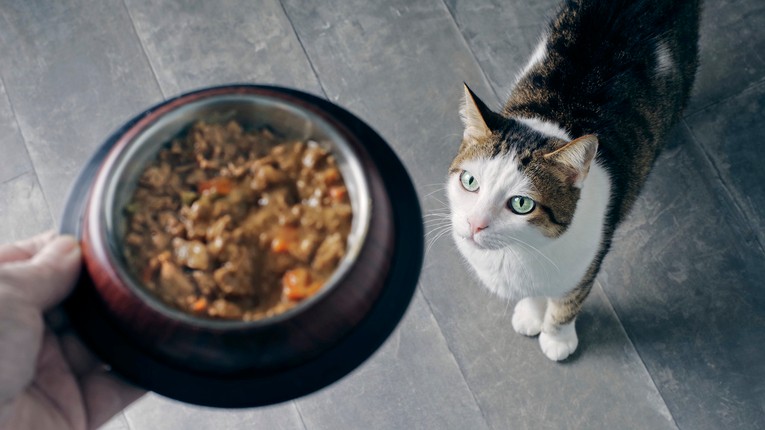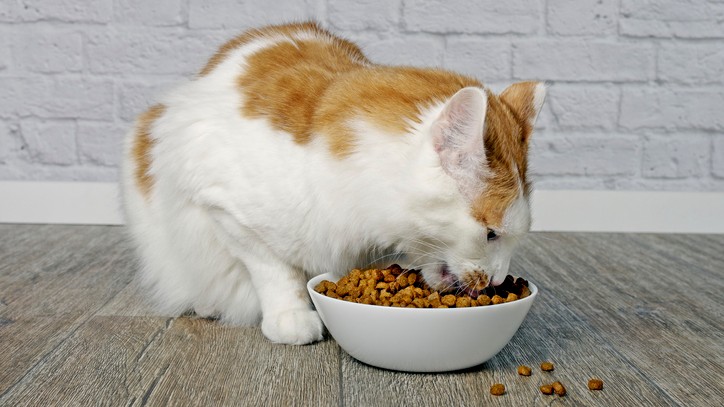Top five cat nutrition myths and misconceptions
With so much information about cat nutrition and diets available, we help you separate the facts from the myths

If you’re like most cat owners looking for information on cat nutrition, the first place that you turn is the internet. (After all, you found this article, didn’t you?) As a veterinarian, though, I read inaccurate online content every day that makes me cringe. Whether you’re trying to sort through internet information, television commercials, or comments from an employee at the pet supply store, it can be challenging to determine whether you’re receiving accurate and factual information, or marketing hype designed to steer you towards a particular brand. Be on the lookout for these common cat nutrition myths and misconceptions.
- The best cat food: Budget buys and premium picks
- The best dry cat foods: King of cat kibble revealed
- The best wet cat food: From daily dishes to tasty treats
- Best kitten food: Six types to feed your new furry feline friend
1. Homemade diets are healthier than commercial diets
In recent years, homemade diets have become increasingly popular among pet owners. The reasons that individuals feed these diets can vary, but they often include two factors: concerns over commercial pet food recalls; and a feeling that homemade diets offer superior nutrition. Unfortunately, neither of these ideas really stand up to criticism.
Recalls of commercial diets can occur for several reasons. In some cases, recalls occur because food has been contaminated by bacteria. In other cases, however, the recall is caused by a nutritional imbalance in the food (too much or too little of a particular vitamin was added to the diet). While both of these are certainly concerning, the recall system uses regular quality-control testing to ensure that contaminated or imbalanced foods reach as few pets as possible. Homemade diets, in contrast, don’t receive the same quality-control testing, and therefore contamination or nutritional imbalances typically go unnoticed.
While there can be health benefits to feeding a homemade diet, these benefits can be difficult to achieve. Unless you are feeding a diet that has been formulated specifically for your cat by a veterinary nutritionist, carefully adding precise amounts of vitamins and minerals, then your homemade diet is unlikely to be as well-balanced as commercial pet food. You can read more about this in our article Homemade cat food vs store bought: Which is best for your cat?
2. Raw-food diets are a healthy option for cats
Unfortunately, raw food can pose a significant threat to both pets and their owners. A 2002 study of dogs eating a diet containing raw chicken found that 80% of the diet samples contained Salmonella, and 30% of the dogs eating this diet had Salmonella in their stool. While this study was conducted in dogs, not cats, it highlights the risks to both pets and owners that are inherent in a raw-food diet. Not only could your pet develop a food-borne illness, but your pet could also spread this illness directly to you through their stool.
A number of organizations have spoken out against the dangers of raw pet food, including the American Veterinary Medical Association (AVMA), the Food and Drug Administration (FDA), and the Centers for Disease Control (CDC). These organizations are concerned about the risk that raw food poses to pets and their owners.
3. Organic or all-natural diets are better than conventional diets
While the term “organic” does carry some meaning in food labels, food that is labelled “natural” may not be what you think it is. Organic food cannot contain synthetic pesticides, fertilizers, or hormones. The word “natural,” in contrast, states only that the food’s ingredients originally came from a plant, animal, or mined source. Regardless of how these ingredients are processed, the food can still be labeled “natural.”
Even if the food truly does meet your expected definition of organic or natural, these definitions don’t provide any information about the quality of the food. Organic or natural food may contain all the vitamins and minerals that your cat needs for growth, or it may be deficient in ingredients. There’s no way to know without conducting further research.

4. Cats need vitamins to supplement their food
If you’re feeding your cat a high-quality commercial diet, it will obtain all of its required vitamins and minerals from that diet. No supplemental vitamins or minerals are needed. In fact, adding vitamins or minerals to a balanced diet could actually result in your cat receiving excessive amounts of these nutrients. The negative effects of a nutrient overdose can be just as significant as the effects of a nutrient deficiency. Therefore, it’s best to feed high-quality cat food and avoid dietary supplements.
5. You can tell a lot about food by reading the ingredients list
While many pet owners look to the ingredients list to assess the quality of the food, the reality is that there is a lot of marketing that occurs within that list. For example, would you rather purchase cat food that contains “beef liver” or “beef by-products?” These two foods could contain exactly the same material (liver is defined as a by-product), but some companies will choose to emphasize “beef liver” while simultaneously criticizing companies that include by-products in their food.
Another important consideration is that the ingredients in food are listed based on weight, not based on the relative contribution of each ingredient to the food’s overall nutritional value. Therefore, ingredients that are high in water (such as muscle meat) can be added in relatively small quantities while still remaining at the top of the list. Ingredients that are lower in water (such as meat meal, which is dehydrated) will naturally fall lower on the ingredient list.
For example, imagine two foods, Food A and Food B. Food A has chicken meat at the top of the ingredients list, followed by a long list of other ingredients. Food B has the exact same ingredients list, except that chicken meat is missing from the first position on the list and chicken meal is instead inserted between the third and fourth ingredients on the list. Which is the better food? Many pet owners would select Food A, based on that ingredients list, but the reality is that there’s no difference in ingredients between the two foods (at least not that can be determined based on the ingredients list).
Do your research
The only way to separate pet food facts from myths is to do your research. When doing so, however, evaluate your sources carefully. Talk to your veterinarian, who received an education in veterinary nutrition, instead of automatically following the advice of a pet food salesman. Look towards pet food manufacturers that employ veterinary nutritionists and other scientific experts, instead of simply reviewing glossy marketing materials. Read articles created by veterinarians and veterinary nutritionists, instead of those created by individuals who don’t have training in that area.
By doing so, you can determine which pet food manufacturers are making science-based recommendations, and find the best food option for your cat.
For more dietary advice for your feline friend, take a look at our guide to is dry cat food best?
PetsRadar Newsletter
Get the best advice, tips and top tech for your beloved Pets
Dr. Barnette is a graduate of the University of Florida, where she received both her B.S. in Zoology and her Doctor of Veterinary Medicine (DVM). She has 15 years of clinical experience as a small animal veterinarian, treating dogs, cats, and occasional exotic patients. She now works as a freelance veterinary writer, creating educational content for veterinarians, veterinary team members, and dedicated pet owners. Dr. Barnette lives in southwest Florida with her husband and daughter (plus two cats, a dog, and a rescued dove!) and enjoys kayaking, biking, and hiking. Learn more about Dr. Barnette at www.linkedin.com/in/catherinebarnette.

